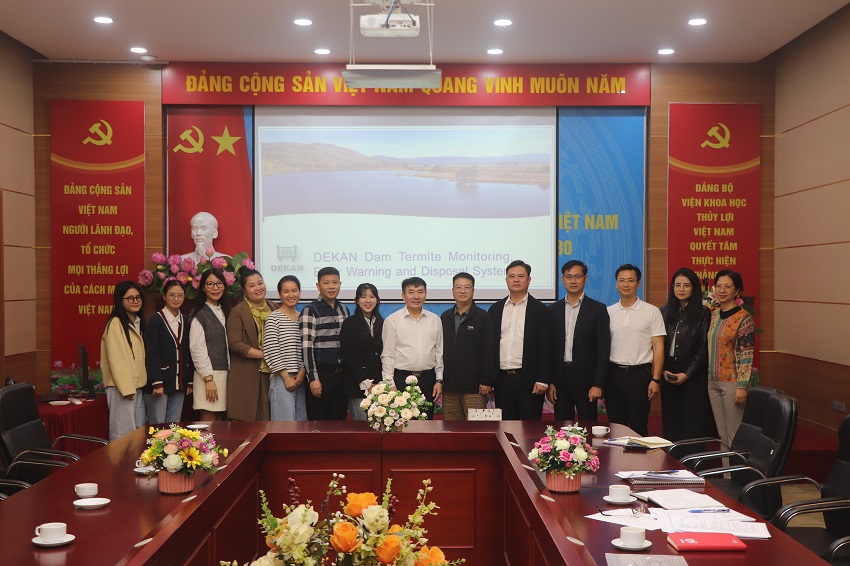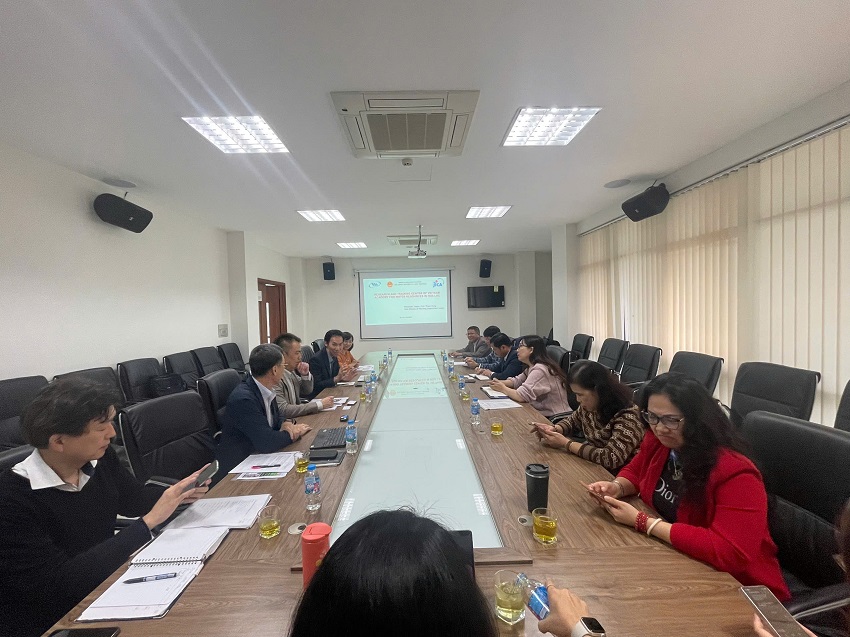Mô phỏng dữ liệu dòng chảy bằng mô hình chi tiết hóa động lực kết hợp với thuật toán học máy: Áp dụng cho lưu vực sông Sài Gòn - Đồng Nai
30/09/2022Trong nghiên cứu khí tượng thủy văn, độ tin cậy của dữ liệu là vấn đề cơ bản, có vai trò quyết định đến các phân tích đánh giá thực trạng. Nghiên cứu này giới thiệu phương pháp mô phỏng thủy văn bằng mô hình thủy văn WEHY kết hợp với kỹ thuật chi tiết hóa kết hợp giữa động lực và thống kê (HD) nhằm cung cấp dữ liệu dòng chảy đáng tin cậy cho lưu vực sông Sài Gòn – Đồng Nai. Dữ liệu khí tượng toàn cầu bao gồm ERA-Interim, ERA-20C và CFSR được sử dụng cho các điều kiện ban đầu và biên cảu mô hình chi tiết hóa động lực WRF. Số liệu chi tiết hóa động lực sẽ tiếp tục được chi tiết hóa bằng thuật toán học máy trong mô hình ANN nhằm nâng cao độ tin cậy của dữ liệu mô phỏng. Phương pháp kết hợp được kiểm định bằng việc so sánh giữa số liệu mô phỏng và số liệu thực đo thu tập từ các trạm trên lưu vực. Kết quả kiểm định cho thấy phương pháp đề xuất có độ tin cậy cao, và có thể tương tự áp dụng cho các lưu vực nghiên cứu khác nhau.
1. ĐẶT VẤN ĐỀ
2. PHƯƠNG PHÁP NGHIÊN CỨU
2.1. Khu vực nghiên cứu
2.2. Phương pháp nghiên cứu
2.2.1. Thiết lập và kiểm định mô hình chi tiết hóa kết hợp
2.2.2. Thiết lập và kiểm định mô hình thủy văn vật lý thực cho lưu vực
3. KẾT QUẢ VÀ THẢO LUẬN
4. KẾT LUẬN
TÀI LIỆU THAM KHẢO
[1] Krishnamurti T.N., Jha B., Rasch P.J., et al. (1997). A high resolution global reanalysis highlighting the winter monsoon. Part I, reanalysis fields. Meteorol Atmos Phys, 64(3–4), 123–150.
[2] Dudley, N.J., 1988. A single decision‐maker approach to irrigation reservoir and farm management decision making. Water Resources Research, 24(5), pp.633-640.
[3] Zhang, F., Guo, P., Engel, B.A., Guo, S., Zhang, C. and Tang, Y., 2019. Planning seasonal irrigation water allocation based on an interval multiobjective multi-stage stochastic programming approach. Agricultural Water Management, 223, p.105692.
[4] Hirpa, F.A., Salamon, P., Beck, H.E., Lorini, V., Alfieri, L., Zsoter, E. and Dadson, S.J., 2018. Calibration of the Global Flood Awareness System (GloFAS) using daily streamflow data. Journal of Hydrology, 566, pp.595-606.
[5] Liu, Y., You, M., Zhu, J., Wang, F. and Ran, R., 2019. Integrated risk assessment for agricultural drought and flood disasters based on entropy information diffusion theory in the middle and lower reaches of the Yangtze River, China. International Journal of Disaster Risk Reduction, 38, p.101194.
[6] Bui, D.T., Hoang, N.D., Pham, T.D., Ngo, P.T.T., Hoa, P.V., Minh, N.Q., Tran, X.T. and Samui, P., 2019. A new intelligence approach based on GIS-based multivariate adaptive regression splines and metaheuristic optimization for predicting flash flood susceptible areas at high-frequency tropical typhoon area. Journal of Hydrology, 575, pp.314-326.
[7] Ho, C., Trinh, T., Nguyen, A., Nguyen, Q., Ercan, A. and Kavvas, M.L., 2019. Reconstruction and evaluation of changes in hydrologic conditions over a transboundary region by a regional climate model coupled with a physically-based hydrology model: Application to Thao river watershed. Science of the total environment, 668, pp.768-779.
[8] Tu, T., Ercan, A., Carr, K.J., Kavvas, M.L., Trinh, T., Ishida, K., Nosacka, J. and Brown, K., 2020. Coupling hydroclimate-hydraulic-sedimentation models to estimate flood inundation and sediment transport during extreme flood events under a changing climate. Science of The Total Environment, 740, p.140117.
[9] Hu, Y., Maskey, S., Uhlenbrook, S. and Zhao, H., 2011. Streamflow trends and climate linkages in the source region of the Yellow River, China. Hydrological Processes, 25(22), pp.3399-3411.
[10] Malik, A., Kumar, A. and Singh, R.P., 2019. Application of heuristic approaches for prediction of hydrological drought using multi-scalar streamflow drought index. Water Resources Management, 33(11), pp.3985-4006.
[11] Bjerklie, D.M., Birkett, C.M., Jones, J.W., Carabajal, C., Rover, J.A., Fulton, J.W. and Garambois, P.A., 2018. Satellite remote sensing estimation of river discharge: Application to the Yukon River Alaska. Journal of hydrology, 561, pp.1000-1018.
[12] Smith, L.C., 1997. Satellite remote sensing of river inundation area, stage, and discharge: A review. Hydrological processes, 11(10), pp.1427-1439.
[13] Gorguner, M., Kavvas, M.L. and Ishida, K., 2019. Assessing the impacts of future climate change on the hydroclimatology of the Gediz Basin in Turkey by using dynamically downscaled CMIP5 projections. Science of the Total Environment, 648, pp.481-499.
[14] Kure, S., Jang, S., Ohara, N., Kavvas, M.L. and Chen, Z.Q., 2013. WEHY-HCM for modeling interactive atmospheric-hydrologic processes at watershed scale. II: Model application to ungauged and sparsely gauged watersheds. Journal of Hydrologic Engineering, 18(10), pp.1272-1281.
[15] Chen, Z.R., Kavvas, M.L., Ohara, N., Anderson, M.L. and Yoon, J., 2011. Coupled regional hydroclimate model and its application to the Tigris-Euphrates basin. Journal of Hydrologic Engineering, 16(12), pp.1059-1070.
[16] Trinh, T., Ishida, K., Fischer, I., Jang, S., Darama, Y., Nosacka, J., Brown, K. and Kavvas, M.L., 2016. New methodology to develop future flood frequency under changing climate by means of physically based numerical atmospheric-hydrologic modeling. Journal of Hydrologic Engineering, 21(4), p.04016001.
[17] Trinh, T., Ishida, K., Kavvas, M.L., Ercan, A. and Carr, K., 2017. Assessment of 21st century drought conditions at Shasta Dam based on dynamically projected water supply conditions by a regional climate model coupled with a physically-based hydrology model. Science of the Total Environment, 586, pp.197-205.
[18] Trinh, T., Coupling regional climate model and machine learning to model high-resolution precipitation, 2021, acapublishing.com.
[19] Trinh, T., Kavvas, M.L., Ishida, K., Ercan, A., Chen, Z.Q., Anderson, M.L., Ho, C. and Nguyen, T., 2018. Integrating global land-cover and soil datasets to update saturated hydraulic conductivity parameterization in hydrologic modeling. Science of the Total Environment, 631, pp.279-288.
[20] Walton DB, Hall A, Berg N, Schwartz M, Sun F (2017) Incorporating snow albedo feedback into downscaled temperature and snow cover projections for California’s sierra Nevada. J Clim 30(4):1417–1438. https://doi.org/10.1175/JCLI-D-16-0168.1
[21] Pierce DW, Das T, Cayan DR, Maurer EP, Miller NL, Bao Y, Kanamitsu M, Yoshimura K, Snyder Mark A, Sloan Lisa C, Franco G, Tyree M (2012) Probabilistic estimates of future changes in California temperature and precipitation using statistical and dynamical downscaling. Clim Dyn 40(3–4):839–856. https://doi. org/10.1007/s00382-012-1337-9
[22] Salathé Jr, E.P., 2003. Comparison of various precipitation downscaling methods for the simulation of streamflow in a rainshadow river basin. International Journal of Climatology: A Journal of the Royal Meteorological Society, 23(8), pp.887-901.
________________________________________________________________________
Chi tiết bài báo xem tại đây: Mô phỏng dữ liệu dòng chảy bằng mô hình chi tiết hóa động lực kết hợp với thuật toán học máy: Áp dụng cho lưu vực sông Sài Gòn - Đồng Nai
Trịnh Quang Toàn
Viện Sinh thái và Bảo vệ công trình
Nguyễn Thị Ngọc Nhẫn
Phòng Thí nghiệm trọng điểm Quốc gia về Động lực học sông biển
TẠP CHÍ KH&CN THỦY LỢI
Ý kiến góp ý:













